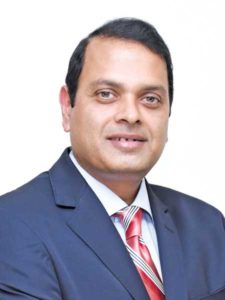ESPOUSING the Perfect Path!
The Horizontal Directional Drilling (HDD) provides a holistic evaluation of the market. Cities are growing quickly, demanding better infrastructure by means of electrical and telecommunication lines, sewer and water pipelines and transport tunnels. Equipment Times looks into the various segments

The Horizontal Directional Drilling (HDD) provides a holistic evaluation of the market. Cities are growing quickly, demanding better infrastructure by means of electrical and telecommunication lines, sewer and water pipelines and transport tunnels.
Equipment Times looks into the various segments as well as an analysis of the trends and factors that are playing a substantial role in the market.
The horizontal directional drilling equipment finds its applications in various end-user industries like telecommunications and oil and gas, these industries are booming and as a result, the global horizontal directional drilling equipment market will also flourish.
Some risks are associated with conventional drilling methods, such as contamination of groundwater. With the horizontal drilling equipment market, these risks can be avoided by adopting advanced trenchless maneuvering technologies. The maneuvering sensors use GPS technology and allow them to overcome any obstructions encountered during drilling beforehand. Horizontal directional drilling is always preferred over conventional boring and micro tunneling methods for digging down bores that are less than six inches below the ground.
Horizontal Directional Drilling (HDD) is a method of installing underground pipelines, cables, and service conduits through trenchless methods. It involves the use of a directional drilling machine, and associated attachments, to accurately drill along the chosen bore path and back ream the required pipe. The first stage consists of drilling a small diameter pilot hole. Drilling fluid is pumped through the drill pipe to the drill bit where high-pressure jets and the bit will grind the soils ahead of the drill stem. The second step is to pre-ream the pilot hole and enlarge it to a size sufficient to safely install the product lines. The final step is the pullback of the pipe within the pre-reamed hole.
The Horizontal Directional Drilling (HDD) technique is used to accurately undertake drilling operations and back ream the required pipe, sidelining various obstacles on the bore path without causing significant collateral damage to the subsurface ecosystems. Rising concerns about the need to minimalize environmental damage caused by rapid infrastructure development across the globe worldwide are contributing significantly to the increased adoption of horizontal directional drilling. Growing utility installations, burgeoning investments in shale gas development projects, and rising expenditures aimed at various developments across the telecom sector to offer high-speed connectivity are some of the other factors contributing to market growth.
According to grandviewresearch.com, over the past few years, the horizontal directional drilling technique has emerged as one of the most popular trenchless drilling technologies. This horizontal boring method requires fewer boreholes to be drilled and maintained. Growth prospects of the industry are subject to heavy investments as the equipment needed for trenchless boring costs much higher than conventional open-cut methods. As the setups are costly, customers opt to rent out the entire setup from contractors. Furthermore, various mid-sized companies also hire service providers for end-to-end projects. As a result, both horizontal directional drilling machine manufacturers and service providers hold a strong position in the market.
Since its inception, the horizontal trenchless technique has gained significant traction owing to its deployment from a single location in extremely rough sub-surface and the ability to hit multiple target zones. The prevalence of disruptive digital technologies, including 3D visualization, 3D earth models, and automation, has led to faster implementation, reduced noise and waste, and enhanced underground accessibility. Additionally, these technologies have enabled engineers, geoscientists, and other related personnel to more accurately visualize and optimize the Rate of Penetration (ROP) of the bore path. Technological advancements have also played a major role in helping the horizontal trenchless technique achieve a prominent position in drilling applications across oilfields, renewable gas exploration, and long-distance optical fiber installations in offshore locations.
Horizontal directional drilling is primarily employed for applications such as the installation of electrical conductors, utility transmission and supply lines, and communication conduits and cables. The cross bore technique that enables the intersection of two or more pipelines underneath the surface poses a threat to these directional boring industry workers and the public. This may be attributed to the lack of visibility in determining the track of the drilling activities in sub-surface locations. The cross-bore intersection of various utilities can often result in explosions, resulting in injuries and death. To avoid this, Occupational Safety and Health Administration (OSHA) mandates directional boring operators to check for structures indicating subversive utility installations or any other obstructions along the drill path before physically drilling entry and exit holes in the required locations. Apart from this, the market is also subjected to various environmental norms that emphasize reducing the ecological impact during underground construction activities.
The Indian Sub-surface
Areas still exist in India where overhead power lines exist and drains are left open. This can be a cause for concern during the monsoon season when heavy cyclonic winds can blow down electric poles and flowing rainwater can overflow drains.
Things are changing though as power lines and drains go underground, and that’s time-consuming and a lot to take on. With miles and miles of sewer pipelines, water pipelines and utility lines running underneath, installing new ones can be very challenging. Most of these are being done using the traditional dig-and-install methods that take up space on the road surface, creating bottlenecks and traffic jams.
Trenchless Technology in India
India has caught up to trenchless technology thanks to organizations like INDSTT, but more on the installation sector than the rehabilitation sector. Cities are growing quickly, demanding better infrastructure by means of electrical and telecommunication lines, sewer and water pipelines and transport tunnels. Now that most of the pipelines have already been laid in the available space below the surface, the only option left is to go deep and install there.
Digging from the surface can be a nightmare especially considering the amount of traffic flowing through cities these days. Not only that; reaching that far down means digging through a maze of pipes and utility lines, which is severely problematic. According to trenchlesspedia.com, it also involves dealing with a lot of excavated soil that has to be safely stored for backfilling or disposed of to a landfill.
Many river crossings such as Brahmaputra-1 River crossing, Narmada River crossing, and Mahanadi River crossing have been conducted using trenchless technology to lay gas and oil pipelines.
However; the greatest need for trenchless technology is in the water and sewer sectors because of the fact that many pipelines are in a state of deterioration and their service life is in serious jeopardy. This means the risk of contaminating groundwater through leaking sewer lines and the wastage of clean water from leaking water pipes is a present problem.
This necessitates new installation in most cases and rehabilitation or replacement where it is possible. For over a century, pipelines have been buried underground to keep the surface sanitary and safe. Repairs were always carried out by trenching from the surface, but now rehabilitating these pipelines that pass under city roads by digging them up is no longer viable.
Trenchless Rehabilitation
The city of New Delhi has the longest sub-surface pipe network with an approximate length of 3000 miles. Some pipelines still exist in Kolkata, Mumbai and Banaras that date back to 100 years. Structural failure and silting are commonly observable in many of these pipelines. Many of the gravity-based pipelines have to be pumped due to sluggish flow caused by improper grade or slope. These problems can be largely attributed to the lack of condition assessment of pipelines on a regular basis.
Condition assessment is essentially an effort undertaken by concerned municipal authorities, to ascertain the condition of existing utilities. It helps determine the structural integrity of the pipeline, its remaining service life, the need for replacement or rehabilitation and assessment for future needs resulting from population growth.
Trenchless technology also offers great methods to study the sub-surface condition of a city without having to dig it up. This is the inspection part of trenchless technology that uses non-destructive methods to study the sub-surface features and inspect inside pipelines using methods such as video inspection and ground-penetrating radar (GPR).
This can help isolate problematic portions in a pipeline that can then be repaired or replaced using the appropriate trenchless method.
Trenchless Market in India
With the increasing awareness of trenchless technology, many parts of the country are adopting it to meet their utility installation and rehabilitation needs. Many projects have been completed and many are underway and in various stages of execution. Cured-in-place pipe (CIPP) and pipe bursting can find a good market in many places where sewer and water pipelines have not lost their structural integrity but where rehabilitation is necessary. CIPP method utilizes a resin-soaked liner that is pulled into a cleaned host pipe and expanded and allowed to cure until it sets. The resulting pipeline is back to form, provided other pipelines in the network are also properly assessed and repaired.
Pipe bursting can be used to replace sections of pipe that have lost their structural integrity. It involves replacing the damaged pipe section by inserting a new pipe section. A conical bursting head at the leading end of the pipe fragments the old pipe and pulls and installs the new pipe behind it. This method does not compromise the capacity of the pipe; in fact, it can help increase it to some extent.
Other methods include sliplining, thermoformed pipe, mechanical spot repair and spray-in-place pipe (SIPP). Trenchless technology is expanding in India with many project owners realizing how much time and effort can be saved while also catering to environmental concerns. Trenchless players in the global scene will benefit greatly by investing in India at this time.
The potential market that needs trenchless installation and rehabilitation methods to meet its sub-surface utility needs is huge. Once these methods are adopted by the local municipal authorities, the benefits of these methods will soon make open trenching obsolete, except where no other option is viable.
Covid-19 impact…
The Covid-19 pandemic resulted in a temporary shutdown of horizontal directional drilling activities at several sites in a range of industries owing to stringent government lockdown regulations to arrest the spread of the disease. The oilfield sector faced major operational concerns as companies temporarily halted upstream and downstream activities, resulting in the abrupt decline in oil and gas production. Furthermore, oil prices dropped owing to a significant reduction in the frequency of transportation worldwide on the heels of a price war among the U.S., Saudi Arabia, and Russia. As a result, incumbents of horizontal directional services and the machine industry faced a downturn in demand. However, continual measures taken by world governments for mitigating the impact of the pandemic on oil and gas exploration companies are expected to allow for recovery in the horizontal directional drilling market in the near future.
Leaders Speak…
 Dr. Niranjan Swarup, Director General, Indian Society, Trenchless Technology (IndSTT) said, “We have been constructing subsurface infrastructure valuing close to about INR 1 lakh crores each year for the last 20-25 years. All this built infrastructure is now needing rehabilitation and replacement services as the utility failures are growing fast. I would like to cite two examples here. First issue is the Non-Revenue Water (NRW) dogging the municipal bodies today. The investment in collecting, purifying, and then pumping the drinking water to consumers get wasted to a large extent due to the NRW. Moreover, the quantum of available water for consumption is also getting reduced at an alarming pace. It is imperative that NRW must be reduced as lowest as possible. Loss of this water and related costs is bleeding the municipal bodies. Second example is the pollution of ground due to failing buried drainage systems. Some of the major rivers today are facing such percolating sewage & sullage in a major way. Even our capital is facing this alarming situation.”
Dr. Niranjan Swarup, Director General, Indian Society, Trenchless Technology (IndSTT) said, “We have been constructing subsurface infrastructure valuing close to about INR 1 lakh crores each year for the last 20-25 years. All this built infrastructure is now needing rehabilitation and replacement services as the utility failures are growing fast. I would like to cite two examples here. First issue is the Non-Revenue Water (NRW) dogging the municipal bodies today. The investment in collecting, purifying, and then pumping the drinking water to consumers get wasted to a large extent due to the NRW. Moreover, the quantum of available water for consumption is also getting reduced at an alarming pace. It is imperative that NRW must be reduced as lowest as possible. Loss of this water and related costs is bleeding the municipal bodies. Second example is the pollution of ground due to failing buried drainage systems. Some of the major rivers today are facing such percolating sewage & sullage in a major way. Even our capital is facing this alarming situation.”
 Safar Mohammad Khan, General Manager – HDD, Apollo Techno Industries, said, “Apollo’s promise to customers is real impact on productivity and profit. Being an OEM and supplier, our primary focus is to provide continuous support to the customers in terms of proper commissioning, technical service and spare parts support across India. In India, our branch offices are equipped with full-fledged parts with proper distribution and transportation facility so that parts could be delivered on time. We have a branch offices at Ahmedabad, Bengaluru, Bhopal, Chennai, Delhi, Kolkata, Lucknow, Mumbai and Rachi. We are the best on parts delivery and the engineer movement on time to provide the resolution.
Safar Mohammad Khan, General Manager – HDD, Apollo Techno Industries, said, “Apollo’s promise to customers is real impact on productivity and profit. Being an OEM and supplier, our primary focus is to provide continuous support to the customers in terms of proper commissioning, technical service and spare parts support across India. In India, our branch offices are equipped with full-fledged parts with proper distribution and transportation facility so that parts could be delivered on time. We have a branch offices at Ahmedabad, Bengaluru, Bhopal, Chennai, Delhi, Kolkata, Lucknow, Mumbai and Rachi. We are the best on parts delivery and the engineer movement on time to provide the resolution.
No matter what the location, Apollo Techno is committed to provide extraordinary after sales support and genuine spare parts to customers. Our nationwide network of engineers and factory trained technicians are always ready to support you with cost-effective service solutions that will keep your machine running at peak performance. Our warehouse operates on SAP ERP that manages and integrates availability of spares on time. We also provide on-site training support on preventive maintenance and equipment safety to the customers’ operators. Our Annual Maintenance Contracts (AMC) is much cost effective option for customer. It is a long-term comprehensive service contract covering unexpected breakdowns, which help to reduce maintenance cost and increase product life.”
 V.G. Sakthikumar, Managing Director, Schwing Stetter India, said, “In the coming days, ‘Trenchless technologies’ method of executing underground jobs will be the norm of the day due to the complexities involved in Underground Routing, considering the Indian Geological conditions and the brimming society expansion which does not allow the over the ground trench cutting especially in metros where crossing of City, Road, River, Canal, Railway crossing and farms. Trench less Technologies for underground drilling is the most effective, efficient and reduces the manpower to a large extent without disturbing the above the ground environment to a large extent. Trenchless Method has a huge prospect in Optic Fibre calle laying, Inter-city and cross country gas pipelines.”
V.G. Sakthikumar, Managing Director, Schwing Stetter India, said, “In the coming days, ‘Trenchless technologies’ method of executing underground jobs will be the norm of the day due to the complexities involved in Underground Routing, considering the Indian Geological conditions and the brimming society expansion which does not allow the over the ground trench cutting especially in metros where crossing of City, Road, River, Canal, Railway crossing and farms. Trench less Technologies for underground drilling is the most effective, efficient and reduces the manpower to a large extent without disturbing the above the ground environment to a large extent. Trenchless Method has a huge prospect in Optic Fibre calle laying, Inter-city and cross country gas pipelines.”
 Ehteshamul Haque, Director Asia Pacific, Digital Control Inc., said, “The traditional application of Trenchless Technology remains in Optical Fiber, Oil and Gas, Electricity Lines as well as some Water and Sewerage network. In all these areas there are projects announced or remains in pipeline. However we should be seeing spurt in ‘Last Mile Connectivity’ for ‘Fiber to Home’ in cities in near term as Jio and Airtel battel it out for high speed internet connectivity bundled with OTT platform. In most cases ‘Households’ are waiting for availability of fiber in there locality. The second area of growth once again comes from telecom sector as government is once again pushing for ‘Remote Area Connectivity’ for the remaining villages as well as ‘U Loop’ connectivity for connected villages to improve uptime.”
Ehteshamul Haque, Director Asia Pacific, Digital Control Inc., said, “The traditional application of Trenchless Technology remains in Optical Fiber, Oil and Gas, Electricity Lines as well as some Water and Sewerage network. In all these areas there are projects announced or remains in pipeline. However we should be seeing spurt in ‘Last Mile Connectivity’ for ‘Fiber to Home’ in cities in near term as Jio and Airtel battel it out for high speed internet connectivity bundled with OTT platform. In most cases ‘Households’ are waiting for availability of fiber in there locality. The second area of growth once again comes from telecom sector as government is once again pushing for ‘Remote Area Connectivity’ for the remaining villages as well as ‘U Loop’ connectivity for connected villages to improve uptime.”
 Dev P. Mehta, Director of Operations, Elgin Separation Solutions – Industrials, said, “The pipeline segment is driving the demand for trenchless equipment the most. The entire country is being connected by underground gas pipelines, from national pipelines, to city level – city gas networks are all driving demand for trenchless equipment. There is a huge environmental and re-developmental impact due to open trenching and major governing bodies are trying to avoid the same. The evolution has been indeed fantastic, the methodologies and technology is indeed at par with what you would see across the world.”
Dev P. Mehta, Director of Operations, Elgin Separation Solutions – Industrials, said, “The pipeline segment is driving the demand for trenchless equipment the most. The entire country is being connected by underground gas pipelines, from national pipelines, to city level – city gas networks are all driving demand for trenchless equipment. There is a huge environmental and re-developmental impact due to open trenching and major governing bodies are trying to avoid the same. The evolution has been indeed fantastic, the methodologies and technology is indeed at par with what you would see across the world.”
 Commenting on the projects where KEC has used HDD technologies, Pankaj Kalani, Chief Executive, Oil & Gas Pipelines, KEC International, said, “HDD technique forms an integral part in both, cross country and city gas distribution pipeline laying projects. This technique is often employed when open cut excavation method is unsuitable or not feasible. Further, with increased regulations concerning environmental protection, drilling in sensitive terrain is sometimes the only way to install new pipelines. At KEC Spur Infrastructure Private Limited, the Oil & Gas Pipelines arm of KEC International, we have deployed HDD technique in all our 22 ongoing projects, some of which include Tundla Gansara Pipeline project for IOCL, Sultanpur Jhajjar Pipeline project GAIL India, KGPL Pipeline project for IHB Ltd., and BGRL Projects.”
Commenting on the projects where KEC has used HDD technologies, Pankaj Kalani, Chief Executive, Oil & Gas Pipelines, KEC International, said, “HDD technique forms an integral part in both, cross country and city gas distribution pipeline laying projects. This technique is often employed when open cut excavation method is unsuitable or not feasible. Further, with increased regulations concerning environmental protection, drilling in sensitive terrain is sometimes the only way to install new pipelines. At KEC Spur Infrastructure Private Limited, the Oil & Gas Pipelines arm of KEC International, we have deployed HDD technique in all our 22 ongoing projects, some of which include Tundla Gansara Pipeline project for IOCL, Sultanpur Jhajjar Pipeline project GAIL India, KGPL Pipeline project for IHB Ltd., and BGRL Projects.”
When asked on how does HDD help in the expedition of projects efficiently, Kalani said, “The traditional open-cut trench method involves excavation of the entire length of the installation area to install pipelines and conduits, and then backfilling the trench. This results in a lot of disturbance from excavation. Open-cut construction activities also create a significant amount noise and dust pollution, disrupting day-to-day activities, especially when a project is being executed in a city. This method may also disrupt underground utilities during excavation. Compared to that, HDD is an alternate method that has simplified and made underground pipeline laying more convenient under different terrains, including wetlands, railway tracks, roads, rivers, lakes, etc., with little or no disruption to environment and other aboveground infrastructure. HDD methodology uses highly advanced drilling equipment and requires less manual labor. It also decreases soil restoration costs and reduces inconveniences caused to landowners when compared with conventional methods.”
Hits: 15








